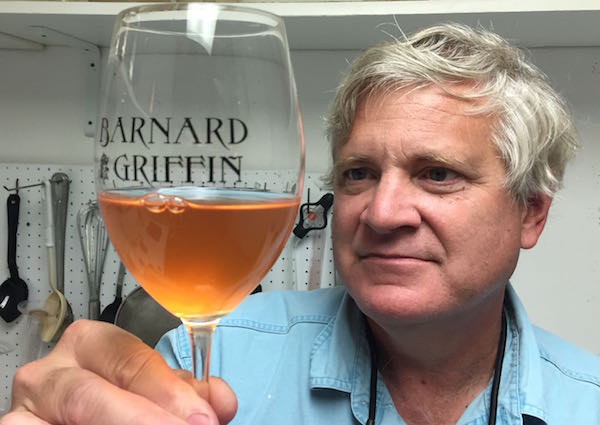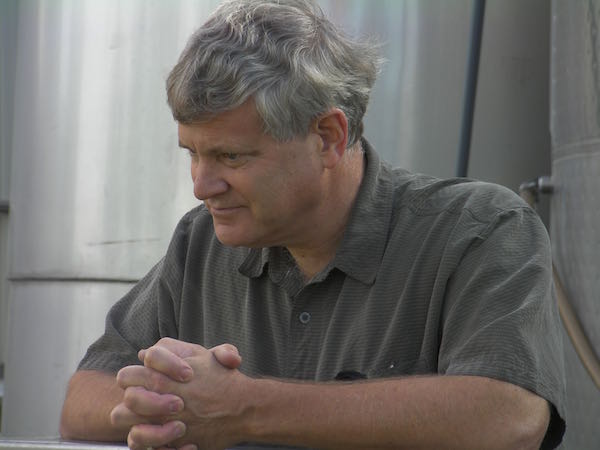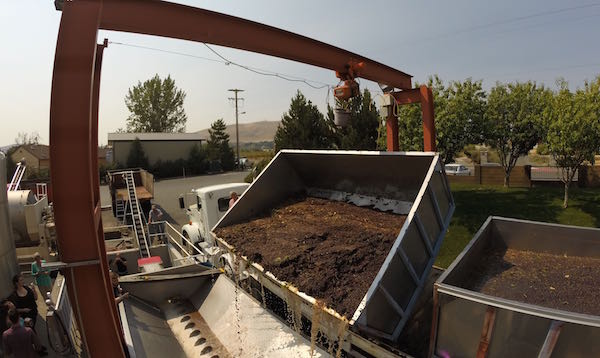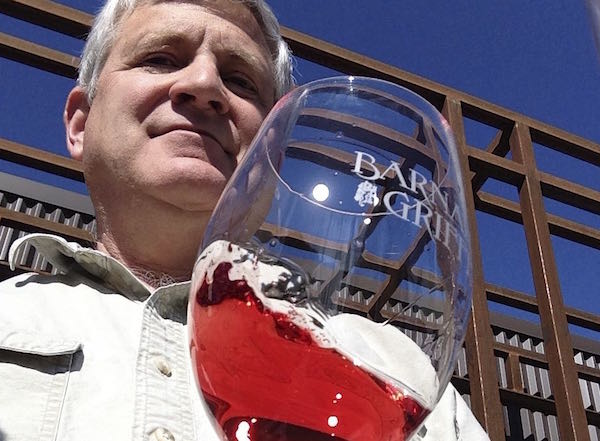
RICHLAND, Wash. – Thanks to a relentlessly warm and early year, the 2015 vintage is Washington will go down as one of the strangest – and possibly most delicious.
Rob Griffin is in a unique position to offer perspective on this year’s grape-growing season, as he has more Washington harvests under his belt than any winemaker in the state.
Griffin arrived here from his native California in 1977, taking over winemaking at Preston Wine Cellars in Pasco in its second year. He launched his own Barnard Griffin in 1983, continuing as a side gig as he oversaw the early growth of Hogue Cellars for nine years.
We recently caught up with the dean of Washington winemakers while he took a break from the crush pad at his winery in the heart of the Columbia Valley.
Here’s the interview:
[powerpress]
Rob Griffin’s California connection

In 1962, Griffin’s uncle – also named Robert Griffin – retired as an electrical engineer and bought 80 acres of land on the Oakville Cross Road, which today is the epicenter of the Napa Valley wine industry. After his uncle took out the prune trees and replanted with grapes, he had Riesling, French Colombard, Cabernet Sauvignon, Pinot Noir and Gamay.
“He had five varieties on a property that I assure now is probably 100 percent Cabernet,” Griffin told Great Northwest Wine.
Griffin’s interest in wine was sparked early, and he made his first batch in high school. This passion led him to attend the University of California-Davis, where he graduated in 1975 with a degree in fermentation science.
Even back then, he was thinking about Washington after visiting the region during a spring break. His first job was at Buena Vista, one of California’s oldest and most historic wineries. A year later, Bill Preston came to California looking for a new winemaker for his young winery. He hired Griffin and brought him to Washington.
Griffin stayed at Preston until 1983, when he and his wife, Deborah Barnard, launched Barnard Griffin with 400 cases. Today, they make about 65,000 cases.
Washington’s strange 2015 vintage

In all of his years in Washington, Griffin had never seen a vintage like 2015. From bud break in March until harvest in mid-August, everything was weeks earlier than normal – even earlier than the historically warm 2014 vintage. In a typical year, Griffin and his fellow winemakers would be about halfway through harvest.
But this isn’t a typical year.
“This would be about the center of mayhem right now,” Griffin said. “This year, we are on a gentle coasting down into oblivion. We have some lots of Cabernet out. Petit Verdot has yet to be picked. The little bit of Malbec we do has yet to be picked. But all of our whites are in. All of our rosé is in. All of our Merlot is in. We’re well on our way to be completed at a very early date.”
Griffin likens this year to last – “just bigger and faster,” he said.
Going into this early harvest, Griffin was concerned about how the chemistry of the grapes would affect his wines.
“I had a lot of trepidation about how early it was because if experience has taught me anything, the very anomalous is usually a problem, not a virtue,” he said.
Yet so far, Griffin is impressed.
“The quality is very good,” he said. “You would expect acidities to be deficient and wines to be flabby, and that’s not the case.”
Part of that was the careful way he picked when acid-to-sugar ratios still were balanced.
“It’s coming together nicely, from my perspective,” he said.
Not that he’s about to declare this “the vintage of the century” or any other kind of silliness.
“Everything’s looking pretty good,” he said. But “you need time to really make sure what you think is there is there. I’m always dubious and a little annoyed at young winemakers who will jump up and down and say this is the best vintage of the century when they haven’t had a month or two to evaluate the wines and they haven’t had the years to compare one to another.”
Griffin likes to joke that the best wine a winemaker has ever made is the one he’s trying to sell at that moment.
“As consumers, you have to be aware of that kind of nonsense,” he said with a chuckle.
More Barnard Griffin rosé in 2015

Of Griffin’s 65,000 cases of production, his Rosé of Sangiovese is one of the biggest. In 2014, he produced more than 10,000 cases, which made him a bit nervous. Yet the wine sold out more quickly than ever. He released it in February, and it was gone from the tasting room by July.
Even though vineyard yields were down because grape clusters weighed a little less, Griffin was able to find a couple of more fruit sources for his rosé and actually will be able to increase production in 2015. He’s also pleased with the quality.
“I have no concerns about how the fruit looks and how the wine is tasting,” he said.
In fact, everything is looking good at this point. Chardonnay, Sauvignon Blanc, Pinot Gris and Syrah all are starting to shape up in the cellar.
Like many winemakers across the state, Griffin has noticed that yields are decidedly lower. He says the excessive heat in June – more than 10 days of triple-digit temperatures – caused berries to be smaller. While this is not necessarily a good thing if you’re a grape grower and getting paid by the ton, it is good for a winemaker hoping to produce a high-quality wine.
Griffin explained that when individual grapes are smaller, the ratio of juice to skin is lower. Flavors and tannins come from the skins, so when there is less juice and more skin, expect bigger, richer red wines.
“These are going to be big, fairly aggressive, mountain man-style wines,” he said. “As opposed to ’11, which because it was so cold, we talked in terms of delicacy and restraint rather than big, bold dimensions.”
This also will lead to what likely will be wines with more powerful alcohol levels.
“It’s just inevitable when it’s this warm,” he said.
Griffin expects to finish harvesting his 800 tons of grapes long before Halloween this year. Right now, he remains a few days ahead of last year.
“In a week, we’ll be tied with last year,” he said. “It has been shocking in the sense that you depend on certain hallmarks of time to tell you when you should be harvesting what – or at least paying attention to it. All of that is out the window this year.”

Leave a Reply